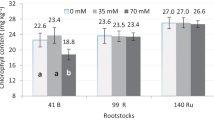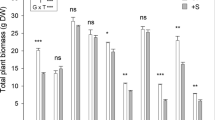Abstract
The search for citrus rootstocks that confer resistance and tolerance to biotic and abiotic factors is increasing. Among abiotic stresses, salinity is one of the main factors that significantly affect growth and development in this crop. Faced this situation, genetic improvement seeks, among other aspects, to generate rootstocks that are tolerant to salinity. In this sense, tissue culture constitutes an important tool for citrus improvement, as it helps in the pre-selection of genotypes that best express salinity tolerance. Thus, this work aimed to study the tolerance of 11 citrus rootstocks to saline stress in vitro, using different concentrations of sodium chloride (NaCl). For analysis of in vitro regeneration, 1 cm long stem apexes, originating from the in vitro cultivation of rootstocks, were introduced in basal WPM medium and supplemented with 0.64, 1.28, 1.92, 2.56 and 3.20 g L−1 of NaCl. After 120 days in a growth room, the plants were evaluated and the data were analyzed using the R statistical program. The genotypes showed different behaviors depending on the interaction between the studied factors. There was a reduction in most of the in vitro development variables of rootstocks grown in culture medium supplemented with NaCl. The ‘Riverside’ citrandarin genotypes, HTR 051, LRF (LCR × TR) - 005, BRS Bravo, TSK × TRBK - Colômbia and BRS H Montenegro, were more tolerant to salinity, while TSKC × CTSW - 028, the mandarin ‘Sunki Tropical’ and BRS Santana were the most sensitive.
Key Message
In this study, we identified genotypes of citrus rootstocks with different levels of salinity tolerance through tissue culture, contributing to genetic improvement and enhancement of citrus production.






Similar content being viewed by others
Data availability
All data generated were analyzed during this study and are included in this published article.
References
Al-Yassin ADNAN (2004) Influence of salinity on citrus: a review paper. J Cent Eur Agric 5(4):263–272
Alam A, Ullah H, Attia A, Datta A (2020) Effects of salinity stress on growth, mineral nutrient accumulation and biochemical parameters of seedlings of three citrus rootstocks. Int J Fruit Sci 20(4):786–804
Anjum MA (2008) Effect of NaCl concentrations in irrigation water on growth and polyamine metabolism in two citrus rootstocks with different levels of salinity tolerance. Acta Physiol Plant 30(1):43
Bilal HH, Zulfiqar R, Adnan M, Umer MS, Islam H, Zaheer H, Ahmad RI (2020) Impact of salinity on citrus production; a review. Int J Appl Res 6(8):173–176
Çimen B (2020) Efficient protoplast isolation from ovule-derived embryogenic callus in Citrus Volkameriana. Turkish J Agric Forestry 44(6):567–576
Flowers TJ, Läuchli A (1983) Sodium versus potassium: substitution and compartmentation. In: Pearson A, Zimmerman MH (eds) Encyclopedia of plant physiology. Springer, Berlin
Garcia MR, Bernet GP, Puchades J, Gomez I, Carbonell EA, Asins MJ (2002) Reliable and easy screening technique for salt tolerance of citrus rootstocks under controlled environments. Aust J Agric Res 53(6):653–662
García-Sánchez F, Syvertsen JP (2006) Salinity tolerance of Cleopatra mandarin and Carrizo citrange citrus rootstock seedlings is affected by CO2enrichment during growth. J Am Soc Hortic Sci 131(1):24–31
Ghaleb WS, Sawwan JS, Akash MW, Al-Abdallat AM (2010) Vitro response of two citrus rootstocks to salt stress. Int J Fruit Sci 10(1):40–53
Kaushal M, Kumar L, Gill MIS, Choudhary OP, Bali SK (2013) Effect of salinity on survival and growth performance of in vitro grown rough lemon (Citrus jambhiri Lush.) seeds. Indian J Biotechnol 12:284–286
Lloyd G, Mccown B (1980) Use of microculture for production and improvement of Rhododendron spp. HortScience 15(3):416–417
Maas EV (1993) Salinity and citriculture. Tree Physiol 12(2):195–216
Madani SM, Piri S, Sedaghathoor S (2022) The response of three mandarin cultivars grafted on sour orange rootstock to salinity stress. Int J Fruit Sci 22(1):264–274
Mahmoud LM, Dutt M, Vincent CI, Grosser JW (2020) Salinity-induced physiological responses of three putative salt tolerant citrus rootstocks. Horticulturae 6(4):90
Munns R, Tester M (2008) Mechanisms of salinity tolerance. Annu Rev Plant Biol 59:651–681
Pérez-Clemente RM, Montoliu A, López P, López-Climent MF, Arbona V, Gómez-Cadenas A (2008) In vitro tissue culture approaches for the study of salt stress in citrus. In biosaline agriculture and high salinity tolerance, Birkhäuser Basel (pp. 37–42)
Pérez-Jiménez M, Pérez-Tornero O (2020) Vitro plant evaluation trial: reliability test of salinity assays in citrus plants. Plants 9(10):1352
Pérez-Jiménez M, Pérez-Tornero O (2020) Mutants of Citrus macrophylla rootstock obtained by gamma radiation improve salt resistance through toxic ion exclusion. Plant Physiol Biochem 155:494–501
Pérez-Tornero O, Tallón CI, Porras I, Navarro JM (2009) Physiological and growth changes in micropropagated Citrus macrophylla explants due to salinity. J Plant Physiol 166(17):1923–1933
Prior LD, Grieve AM, Bevington KB, Slavich PG (2007) Long-term effects of saline irrigation water on ‘Valencia’orange trees: relationships between growth and yield, and salt levels in soil and leaves. Aust J Agric Res 58(4):349–358
R Core Team, 2016. R: A Language and Environment For Statistical Computing. R Foundation for Statistical Computing, Vienna, Austria http://www.R-project.org/. Acesso em 27 de outubro de 2019.
Sharma LK, Kaushal M, Bali SK, Choudhary OP (2013) Evaluation of rough lemon (Citrus jambhiri Lush.) as rootstock for salinity tolerance at seedling stage under invitro conditions. Afr J Biotechnol 12(44):6267–6275
Shibli R, Mohammad M, Abu-Ein A, Shatnawi M (2000) Growth and micronutrient acquisition of some apple varieties in response to gradual in vitro induced salinity. J Plant Nutr 23(9):1209–1215
Shiyab SM, Shibli RA, Mohammad MM (2003) Influence of sodium chloride salt stress on growth and nutrient acquisition of sour orange in vitro. J Plant Nutr 26(5):985–996
Sotiropoulos TE, Dimassi KN, Tsirakoglou V, Therios IN (2006) Responses of two Prunus rootstocks to KCl induced salinity in vitro. Biol Plant 50(3):477–480
Syvertsen JP, Melgar JC, García-Sánchez F (2010) Salinity tolerance and leaf water use efficiency in Citrus. J Am Soc Hortic Sci 135(1):33–39
Yaman M, Pınar H, Seday U, Altınöz D, Uzun A, Çabuk NS (2020) screening for Salt Tolerance of some Citrus rootstocks. Turkish J Agriculture-Food Sci Technol 8(5):1117–1121
Ziogas V, Tanou G, Morianou G, Kourgialas N (2021) Drought and salinity in citriculture: optimal practices to alleviate salinity and water stress. Agronomy 11(7):1283
Acknowledgments
The author expresses her sincere thanks to Dr. Antônio da Silva Souza for his invaluable support, valuable guidance and excellent work, as well as for the fundamental review of the manuscript. Your dedication and contribution were essential to the quality of this work.
Funding
To CAPES and FAPESB, for their financial support for the scholarships of the students involved in the study. To Embrapa Mandiocae Fruticultura, for providing the physical structure and financial.
support for the development of the study.
Author information
Authors and Affiliations
Contributions
DSVV, MISM and LVCN: collected the data and interpreted the results. DSVV and MISM: wrote the manuscript. DSVV, MISM, ASS, KCFS and WSSF: provided technical support to set up and conduct the study. ASS, KCFS, and WSSF: defined the main lines of the experiments. DSVV: supported the statistical analysis. ASS, KCFS and WSSF: were the supervisors of this research. ASS, WSSF and KCFS: contributed with the financial acquisition of the experiments.
Corresponding author
Ethics declarations
Conflict of interest
The authors declare that they have no known competing fnancial interests or personal relationships that could have appeared to infuence the work reported in this paper.
Additional information
Communicated by Maria Antonietta Germanà.
Publisher’s Note
Springer Nature remains neutral with regard to jurisdictional claims in published maps and institutional affiliations.
Rights and permissions
Springer Nature or its licensor (e.g. a society or other partner) holds exclusive rights to this article under a publishing agreement with the author(s) or other rightsholder(s); author self-archiving of the accepted manuscript version of this article is solely governed by the terms of such publishing agreement and applicable law.
About this article
Cite this article
Vila Verde, D.d., Mendes, M.I.d., Nobre, L.V.d. et al. In vitro tolerance of citrus rootstocks under saline stress. Plant Cell Tiss Organ Cult 156, 13 (2024). https://doi.org/10.1007/s11240-023-02627-y
Received:
Accepted:
Published:
DOI: https://doi.org/10.1007/s11240-023-02627-y




